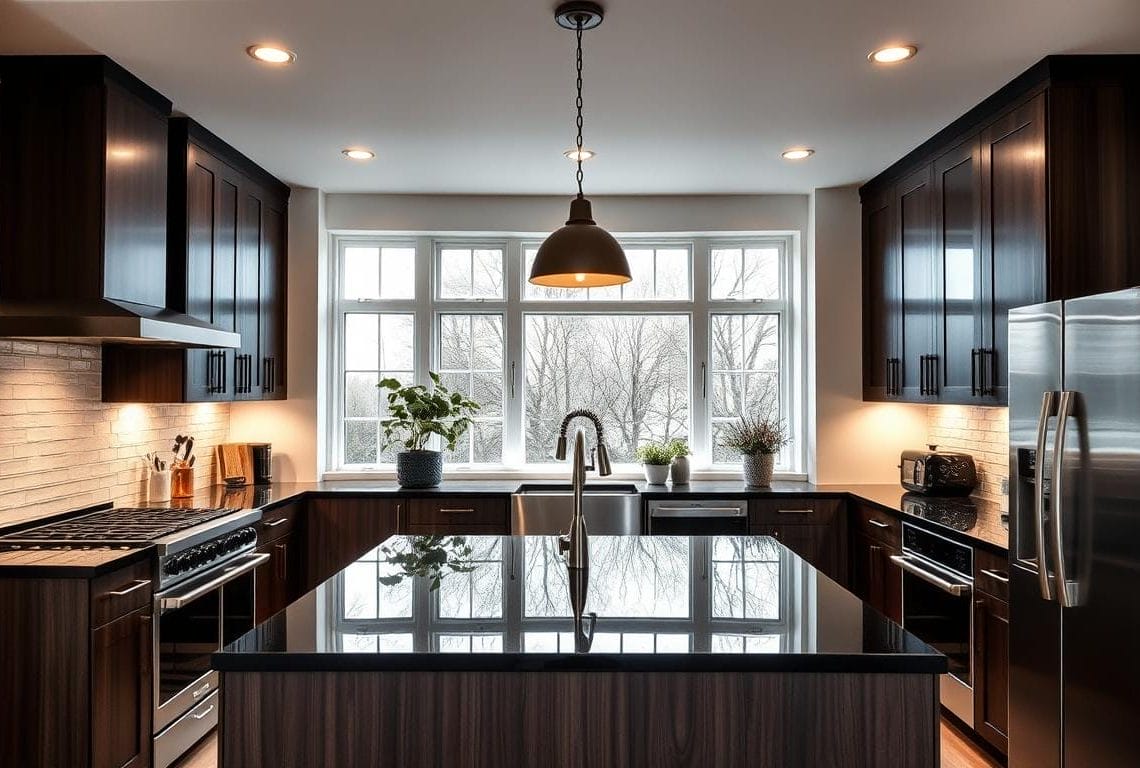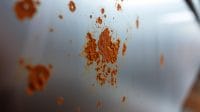Curious which finish will hold up in a busy kitchen: the shiny classic or the darker trend?
Consumers once flocked to dark-coated ranges and fridges, but that surge has fallen from about 20–30% of U.S. kitchen packages to under 1% today.
The key issue is simple: many dark finishes are coatings over bare metal. Scratches reveal bright metal beneath and often cannot be repaired. Bosch’s baked-in method is one notable exception; it resists wear better than most coated doors.
This guide gives a clear framework: what each finish is, how it wears, how to install units correctly, and how to clean them without harm.
Read on for practical comparisons, brand notes, and installation checklists that help homeowners and tradespeople pick a look that lasts and fits their budget.
Quick A vs. B Overview: Regular Stainless vs. Black Stainless at a Glance
A quick head-to-head shows where each finish wins and where it loses. For many homeowners the decision comes down to daily cleaning, long-term wear, and how well a single brand will match future purchases.
At a glance:
- Regular stainless steel appliances: Timeless, widely available, and easiest to mix across brands. Uncoated metal can show fingerprints and streaks; many owners use a dedicated stainless cleaner for a uniform sheen.
- Black stainless: Most versions are coated—Samsung calls one approach an acrylic dual-layer—so light smudges wipe away with a damp cloth and a soft towel. But deep scratches reveal the bright metal underneath and are harder to conceal.
- Market reality: Houzz data shows about 73% choose classic finishes versus roughly 8% for dark-coated options. That affects selection, replacement, and color matching if you mix manufacturers.
Quick rule: pick regular for long-term flexibility and resale; pick black stainless for a specific look and lighter maintenance—while accepting scratch and color-match risks. For more detail on mixing finishes and brand notes, see stainless and black appliances.
What Each Finish Really Is: Materials, Coatings, and How They’re Made
A finish’s construction—layer by layer—explains why some marks vanish and others do not.
Regular stainless steel is simple: it’s bare metal with a visible grain. Wiping with the grain cuts streaks and reduces micro-scratches. Finish options range from brushed to treated smudge-resistant surfaces; many owners still use a dedicated cleaner for the most even sheen.
Black coated options: acrylic, polymer, and tinted layers
Most black stainless products start with the same base metal and gain color through a topcoat. Brands describe multiple-layer systems—Samsung cites two coats (one for color, one for smudge resistance). Frigidaire compares its polymer finish to automotive clearcoats: durable but scratchable. KitchenAid notes touch-up paint may be offered.
What “fingerprint-resistant” claims mean
Those claims usually come from chemistry in the topcoat. A proper coat reduces print transfer and makes marks easier to remove with warm water and a soft cloth. Bosch takes a different route: a modified base material it says limits scratches and prints and recommends avoiding standard stainless cleaners.
- Key takeaway: the material stack—base metal, color layer, protective topcoat—determines repairability and long-term color match.
- Care note: avoid abrasives and harsh chemicals; use mild soap, water, and a soft cloth for coated finishes.

Present-Time Market Reality in the United States
What was once a mainstream trend has narrowed into a fragile niche in U.S. kitchens. From roughly 2016–2018, dark-coated finishes captured 20–30% of kitchen packages. Today that share sits under 1% and continues to fall.
Why the drop? Durability complaints—coatings that scratch or peel to reveal bright metal—drove returns and service calls. Retailers reacted by limiting stock. Lawsuits and repair problems accelerated shifts in product planning.
Brand pivots matter:
- Samsung moved toward Matte Black while premium manufacturers—Café, Profile, BlueStar, Fisher & Paykel, Wolf—invest in true black finishes that do not rely on a thin topcoat.
- That shift raises discontinuation risk for older coated lines and makes replacement matching harder if a unit fails.
- End-of-line pricing can appear attractive, but buyers must weigh future availability and suite coordination.
The present choice for U.S. consumers is pragmatic: favor finishes with staying power—regular stainless, matte black, or panel-ready—when planning a long-term kitchen. Consider lifecycle costs, serviceability, and resale, not only the initial color appeal.

Head-to-Head Pros and Cons Grounded in Real Use
Home tests and service reports reveal clear trade-offs between looks and long-term wear. This section compares real-world durability, cleaning habits, color matching, and repair options so readers can choose with confidence.
Durability and scratches: exposed bright metal vs. baked-in options
Regular stainless shows wear as fine swirls; the surface is uniform metal so marks blend more easily. Coated finishes risk high-contrast scratches that reveal bright metal beneath.
Bosch’s baked-in method performs better in scratch tests than polymer or acrylic topcoats from other brands.
Cleaning and fingerprints: warm water and cloth vs. stainless cleaners
Coated finishes typically wipe clean with warm water and a soft cloth. Uncoated stainless steel appliances often look best after a dedicated stainless cleaner pass.
Avoid abrasive powders—grease plus grit causes micro-marring on both types.
Color match and mixing across brands: why finishes vary
Black tones differ in tint, gloss, and reflectivity. Mixing manufacturers can create a mismatched suite.
Repairability and touch-up paint: what manufacturers say
- Repair limits: deep coating scratches rarely disappear; touch-up paint may help but seldom matches perfectly.
- High-traffic spots: handles and edges show wear first—use nonabrasive cloths and limit rough contact.
- Practical choice: for heavy use homes, regular stainless or true baked-in dark finishes are safer long-term.

Kitchen Design Tips: Getting the Look Right with Either Finish
Pick appliance tones that support your cabinetry and lighting, not fight them. Start by sampling finishes next to cabinet doors and your countertop in the room where the work will happen.
Cabinetry pairing: painted, deep wood, and modern slab fronts
White, gray, and natural wood offer a safe backdrop for stainless steel appliances; they keep the palette flexible.
Deep wood or painted cabinets anchor a suite with black stainless for a warm, modern look. For slab fronts, favor matte surfaces to limit glare.
Countertops and backsplash: matte, gloss, and contrast strategies
Pair lighter quartz with dark finishes for crisp contrast. If your backsplash is glossy, choose a brushed or satin appliance finish to reduce shine competition.
Lighting and hardware: brass, copper, and dark trims that play well
Hardware choice changes perception: brass or copper pops against darker finishes. Brushed nickel works best with stainless tones for a cohesive suite.
Small kitchens and open plans: reflections, glare, and visual weight
A full set of dark finishes can shrink a small kitchen. Mix lighter cabinetry and strong task lighting to preserve openness. Always view samples under your project lighting and, when possible, compare options side-by-side.

- Texture tip: combine matte backsplashes with satin appliance finishes to add depth without busy reflections.
- Practical note: true matte lines from Café, BlueStar, Fisher & Paykel, and Wolf offer more consistent color across a suite.
Installation and Maintenance Guide for Everyday Consumers
Start the installation with a clear plan: protect finished doors, verify clearances, and set a simple cleaning routine. These three steps cut service calls and extend the life of kitchen units.
Delivery and handling
Keep factory films on until the unit is in final position. Use moving blankets, corner guards, and avoid sliding doors across tile edges. For coated finishes, request white-glove placement to reduce tool marks and door rubs.
Clearances, panels, and trims
Measure hinge swing, range side gaps, and dishwasher panel alignment before final fastening. Dry-fit any panel-ready trim and confirm reveals under your lighting. Use manufacturer trim kits and filler pieces for a built-in, even-gap look.

Cleaning routines and small repairs
Daily care: start with warm water and a soft microfiber cloth. For grease, add mild soap, rinse with water, and dry with a clean cloth to avoid mineral spots.
Avoid abrasives, scouring pads, and strong solvents; many brands warn that some polishes can haze coated finishes. Record model and serial numbers and keep the install guides—manufacturers list door-adjustment steps useful after settlement.
If a nick happens, consult the maker about touch-up paint. Expect camouflage rather than a perfect match—deep scratches that expose bright metal are hard to hide. After installation, retorque leveling legs and recheck door clearances once the appliance is loaded to prevent chronic handle rubs and future scratches.
Brands, Finishes, and Manufacturer Differences That Matter
Manufacturer methods vary widely, and those differences change cleaning, repair, and matching decisions.
Bosch’s baked-in approach
Bosch markets a baked-in dark finish that resists scratches and fingerprints better than surface coats. It also recommends mild soap and water instead of typical stainless cleaners to avoid haze.
Acrylic and polymer coatings: Samsung, LG, KitchenAid, Frigidaire
Samsung uses an acrylic two-layer system — color plus fingerprint resistance — while LG offers a matte coated option that reduces glare. KitchenAid applies a tinted coat and supplies touch-up paint in some cases. Frigidaire compares its polymer finish to an automotive clearcoat: durable but still scratchable.

Mixing brands vs. staying consistent
Key point: a mixed stainless suite usually matches across makers; a mixed dark suite often does not. Tints, gloss, and grain differ. Sticking to one brand for a dark finish lowers the risk of visible mismatch.
- Practical tip: confirm each maker’s care instructions and plan replacements from brands with active roadmaps.
- Cleaning help: see our guide on cleaning black stainless.
stainless steel and black appliances: Cost, Longevity, and Resale Value
Price tags and upkeep tell very different stories over a product’s useful life. For buyers weighing short-term deals, discounted kitchen appliances may seem attractive. Retailers have liquidated dark-coated stock during demand spikes, but many lines were later discontinued due to finish issues.
Upfront pricing vs. lifetime durability: Closeouts on black stainless steel can save money today. However, scratch visibility and limited repair options often erase that advantage over time.
Future-proofing and resale: Regular stainless steel appliances remain easiest to match and service. Consumers find parts and panels for common finishes faster and cheaper than for niche lines.
Key points to consider:
- Short-term bargains may require full-suite replacement later to maintain visual consistency.
- Technicians stock more parts for common steel appliances; rare finishes slow service.
- Resale buyers favor recognized finishes—stainless steel kitchen choices broaden appeal.

In the end, the smart choice balances day-one look with long-term availability, service costs, and resale expectations.
Smart Takeaways for Choosing the Right Finish for Your Kitchen
Durability, repairability, and service access should lead the finish-selection checklist. For long-term flexibility, a regular stainless route wins: wide availability, easier part swaps, and simple matchup across brands.
If the look drives the choice, accept trade-offs. Dark-coated options clean well with water and a soft cloth but show deep scratches that reveal metal beneath. Bosch’s baked-in method and true matte lines from Café, BlueStar, Fisher & Paykel, or Wolf reduce that risk.
Inspect floor models under bright light. Bring a cabinet sample and compare color, gloss, and grain across manufacturers. Plan replacements: a single unit swap is easier in a stainless steel kitchen than in suites of black stainless-steel appliances.
Bottom line: match finish to household use—people with kids or heavy traffic should favor resilience; designers seeking a specific color or matte finish can proceed, but buy with a full suite and service plan.






